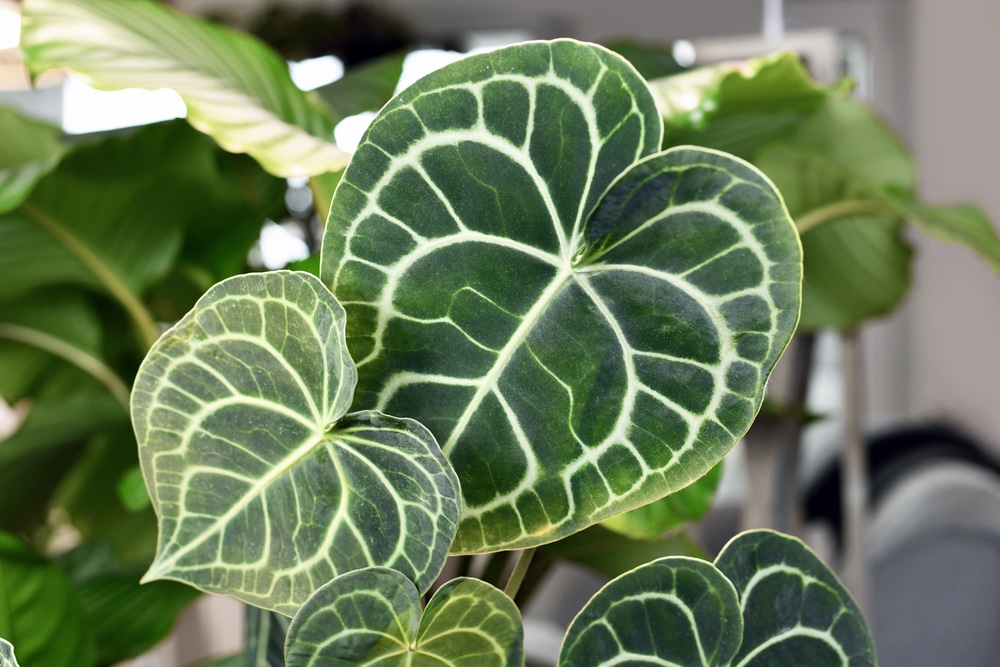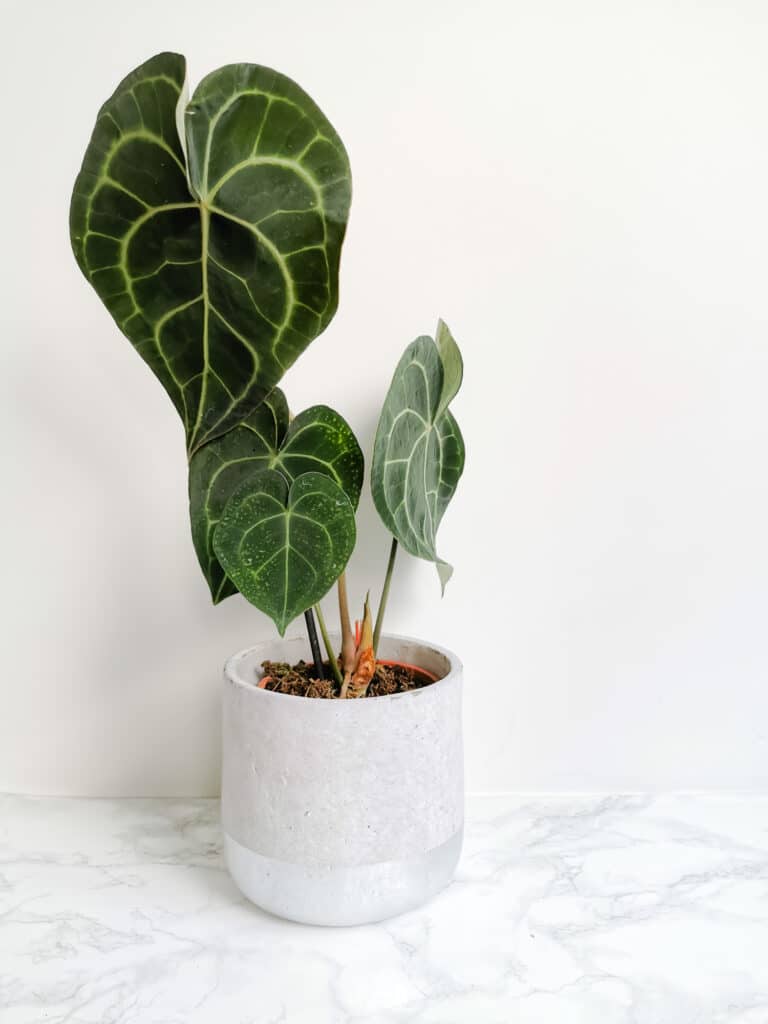If you’re looking for a houseplant with big, breathtaking leaves, your search is over. The Anthurium clarinervium, often referred to as the velvet cardboard anthurium, has spectacular foliage. While many plants are prized for their flowers and bright colors, the Anthurium clarinervium takes the prize for its greenery.
This plant is fairly beginner friendly, as its care isn’t overly complex or complicated. Once you understand its natural conditions, it’s easy enough to maintain. Most anthuriums live around five years with proper care, though they can stick around longer, so expect your Anthurium clarinervium to stick with you for a while.
These plants are native to Mexico and grow in rocky landscapes rich in limestone. It doesn’t root in soil naturally, and you’ll find it growing on rocks, instead. Anthurium clarinervium is toxic to humans and animals, so keep any four-legged friends and small children away from the plant. Every part of the plant is harmful to dogs and cats, so get vet assistance if your pet chews or ingests it.
| Common Name | Velvet Cardboard Anthurium |
| Botanical Name | Anthurium clarinervium |
| Native Area | Mexico |
| Sun/Light Requirements | Bright, indirect light for 6+ hours |
| Soil | Well-draining, slightly acidic |
| Temperature | 70°F to 90°F |
| Humidity | Between 65% and 80% |
| Size | Up to 30 in. |
| Hardiness Zones | USDA zones 9 to 11 |
Appearance

The Anthurium clarinervium has one show-stopping feature – its leaves. They’re giant, bold, and gorgeous. Healthy plants have dark green, heart-shaped leaves that can grow up to one foot in width. Each leaf sports a thick white or silver vein that weaves patterns on the surface. It stands out against the deep green, giving the Anthurium clarinervium its unique look.
While this plant’s leaves are its trademark, it does flower. Similar to other anthurium varieties, it develops a spathe with a cream or white-colored spadix at the center. The spadix houses tons of small flowers, but a flowering Anthurium clarinervium isn’t showy.
There are a few different variations of Anthurium clarinervium, some resulting from crossing that plant with others. Some variations have longer or larger leaves, and others have lighter veining. There isn’t a lot of variation for the plant in the wild, however, so you won’t see a spray of different colors or changes in the Anthurium clarinervium.
Care Instructions
Your Anthurium clarinervium won’t be the neediest plant in your collection, but it does have specific requirements to meet. There are certain things to pay attention to, given its rocky origins and the fact that it doesn’t naturally grow in soil. Below are all the care tips and tricks necessary to maintain a happy and flourishing velvet cardboard anthurium.
Light Requirements
Bright, indirect light is your best bet with the Anthurium clarinervium. Too much direct sunlight will burn and damage the leaves, making it a particular tragedy for a plant made popular for its foliage. Six hours of indirect light each day is enough for healthy growth. If you’re looking for the perfect spot, try an east-facing window.
While the velvet cardboard anthurium doesn’t handle direct light well, too little light is harmful, too. If the leaves are lackluster, smaller than expected, or the plant grows slowly, look for an area with more indirect light.
Water
Keep your Anthurium clarinervium moist without overwatering it. They’re sensitive to waterlogging, as they don’t grow naturally in soil, so don’t leave them soggy. Instead, wait until the top couple of inches of soil is dry before watering again. During the growing season, watering two to three times per week is usually sufficient. Check the soil to be certain. During winter, you can cut that down to once per week.
Soil
Since soil isn’t its natural growing medium, Anthurium clarinervium needs very well-draining soil. Don’t leave it sitting in any water. The plant does best when moist – not wet. Orchid mixes are solid options. Add in extra wood chips or perlite for extra draining. The last thing you want to do is invite root rot!
Temperature
Velvet cardboard anthuriums like it warm. Their native area rarely dips below 65°F, so optimal temperatures for this plant are between 70°F and 90°F. If you keep things on the chilly side, make sure your plant isn’t exposed to temperatures below 60°F for long. It doesn’t tolerate cold well.
Humidity
Like temperatures, Anthurium clarinervium prefers humidity on the higher side. Ideal humidity levels sit between 65% and 80% but should never go below 50%. Mist your Anthurium clarinervium daily with room temperature water if you need help with humidity levels. Pebble trays with water or grouping plants together help, too. If Anthurium clarinervium is your only tropical plant, it could require some humidity and TLC, but you likely already have an appropriate area if you keep other tropical varieties.
Fertilizer
These plants grow on rocks in the wild, so they don’t need a lot of help from fertilizer. They get their nutrients in other ways. However, fertilizer is helpful during the growing season, as long as it’s used sparsely. A 20-20-20 fertilizer diluted to half-strength works well. Feed it once a month, or as long as once every two months, during the growing season. There’s no need to fertilize during the fall or winter, as this plant’s growing season ends around September.
Pruning
There isn’t a lot of pruning work for Anthurium clarinervium, but occasionally you’ll need to remove dead or dying leaves and stems. If they’re left attached to the plant, it will continue to work and waste energy attempting to bring them back. If you can’t pluck the stem off, use a clean pair of pruning shears to snip it off near the base of the stem.
Propagation
Anthurium clarinervium makes its own pups, so propagation is exceedingly simple. Separate the pups from the main plant and place them in their individual pots. Water them, give them the correct amount of light, and they’ll do the rest of the work to root.
It’s possible to propagate Anthurium clarinervium from stem cuttings or grow it from seeds, but neither method is as simple as dividing the pups from the mother plant.

Repotting
Count on repotting Anthurium clarinervium every two to three years. It presents the perfect opportunity to separate any pups, too. You’ll know when it’s time to repot if you see roots filling up the current container or starting to go around the pot. Size up your container by two inches or so.
One noteworthy quirk of the Anthurium clarinervium is its ability to stick to clay or terracotta pots. In the wild, they grow on rocks, so they mimic the behavior if they’re planted in a container that allows it. If you choose to plant them in terracotta, the safest way to remove them is to break the pot. Otherwise, you risk ripping and damaging the roots. To avoid that altogether, opt for a plastic container with good drainage.
Pests and Insects
Anthurium clarinervium is at risk for the usual fodder of houseplant pests. Aphids, mealybugs, spider mites, fungus gnats, and scale bugs are all possible nuisances. Look out for any signs of an infestation. Damaged leaves and discoloration are both potential indicators of pest activity. Isolate and treat the plant right away if it’s playing host to pests. Neem oil and horticultural soaps are both safe treatment options. You can spray the plant or rub the leaves, depending on the product.
To keep pests at bay, watch your watering habits carefully. Overwatering causes rot, mold, and decay, which all attract pests to come close. Besides, the Anthurium clarinervium doesn’t enjoy being too wet, so it’s better plant care all around.
Extra Tips
Every plant has its unique quirks and idiosyncrasies and caring for those quirks helps the plant thrive. Here are a few additional things to do that ensure your Anthurium clarinervium remains healthy, happy, and growing.
Fresh Air
In nature, these plants are accustomed to moving air when they cling to rocks. They do best with gentle fresh air but make sure it isn’t a cold draft or very hot. During summer days, open the window they’re near and let them bask.
Acidic Soil
In addition to well-draining soil, Anthurium clarinervium prefers things a bit more on the acidic side. 5.5 pH to 6.5 pH is ideal.
Final Thoughts
Whether you’re looking to liven up your home office or add a dash of green to the living room, the Anthurium clarinervium is an excellent candidate. From its beautiful color to the mesmerizing patterns of veins, it livens up any room. Care isn’t overly difficult and there are ways to revive the plant even if you have a mishap, so there’s some forgiveness with the Anthurium clarinervium, too. With the right environment, your velvet cardboard anthurium will flourish all year.

